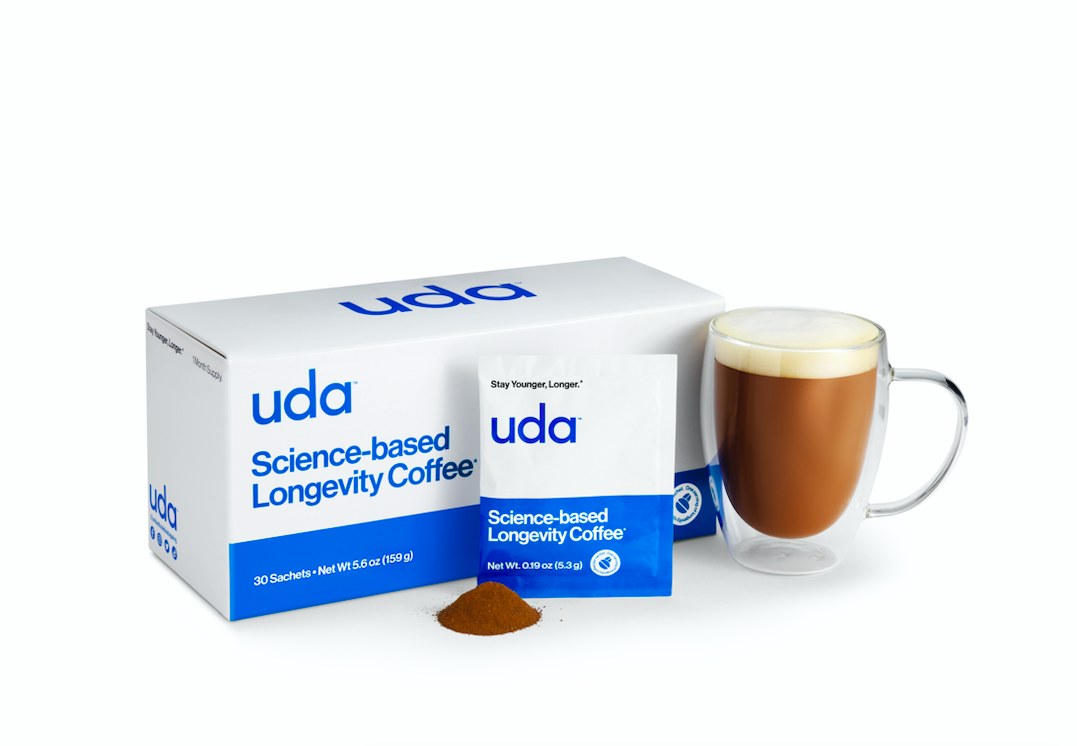Could this cup of coffee be the real fountain of youth?

uda – the one-of-a-kind coffee formula – has now launched, introducing a profile of products engineered to help its consumers live healthier, for longer. Backed and formulated by Oxford and Harvard biologists, uda is the first longevity-focused consumer brand clinically proven to extend our lifespans in the form of a coffee sachet, making longevity an easy and habitual practice.
Research into longevity has progressed at a fast pace in recent years, but increasing public interest has created an environment in which unfounded claims can be difficult to separate from scientific facts. The key to anti-aging lies in one fundamental process – stem cell regeneration – which can only be done by making lifestyle changes that target cellular activity that makes these cells replenish themselves faster – reducing inflammation and modulating the immune system. uda’s team of Oxford and Harvard scientists, molecular biologists and geneticists screened databases of over 20,000 research chemicals known to affect core biological pathways involved in longevity.
uda looked at 171,000 Britons and found that those who drank two cups of coffee a day were less likely to die of terminal illness than non-coffee drinkers – so, while our coffee shop subscriptions are not scientifically engineered to help us live longer, they aren’t hurting our chances. Yet, uda’s formula could be the scientific discovery we’ve all been waiting for, making the fountain of youth as accessible as our morning coffee.
What’s in uda?
Each coffee sachet contains seven key ingredients that are proven to aid anti-aging by promoting stem cell regeneration:
Ashwagandha
Ashwagandha is a revered Ayurvedic medicinal herb, which has come to be further studied by scientists today. It is revered for its adaptogenic properties, and has been used for millenia to relieve stress, fatigue, and insomnia. A rich source of phytochemicals, Ashwagandha has been proven to support the body and aid recovery, while also acting synergistically with coffee.
Quercetin
Quercetin is a naturally occurring polyphenol and is a known anti-inflammatory and anti-oxidant. On top of its proven effects in mitigating cellular damage, scientists have recently found that quercetin is able to directly remove harmful older cells before they accumulate in the body. This makes quercetin a powerful senolytic and a key part of uda’s formula.
Alpha-ketoglutarate
AKG is produced by the body during metabolism, but as we age, scientists have shown that AKG levels decline, and this is linked with functional decline! AKG has been studied by longevity scientists, who have shown that supplementing the AKG that is lost with age can reverse biological ageing by 8 years or more, as measured by the epigenetic clocks. uda is packed with AKG to combat the loss of this key part of cellular energy levels and metabolism with age.
L-theanine
L-theanine is an amino acid that has been used by many to enhance the experience of drinking coffee. Not only does it make the experience smoother and richer, but brain-scan studies have shown that L-theanine on its own can enhance focus, attention, and clarity of thought.
Curcumin
Curcumin, found in yellow turmeric spice, is a powerful antioxidant that reduces cellular damage. It also enhances immune system function, which is otherwise known to decline with age.
NMN
Nicotinamide mononucleotide is one of the most promising longevity molecules right now. NMN directly increases levels of a key signalling molecule called NAD, which declines with age and is linked to loss of DNA repair and maintenance ability. NMN has been studied by scientists for its ability to reverse several key components of the ageing process.
Vitamin D
Vitamin D is made naturally in our skin upon exposure to sunlight, but scientists have shown that a large percentage of adults are deficient! Vitamin D is not only involved in promoting healthy skeletal ageing, but it is additionally incredibly important in signalling molecule which interacts with genes known to be associated with healthy longevity.
Where can I buy uda?
Following the launch on 1st November, uda’s coffee formula will be available from their website, with a one-month supply starting at £81. Each sachet includes barista-style coffee, meaning uda can replace your daily coffee run.






